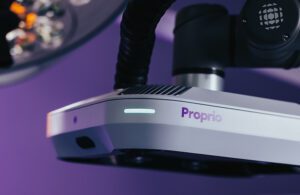Light field technology and AI empowers surgeons with real-time feedback and enhanced perception for unparalleled precision and patient care.

Proprio designed its Paradigm system to help surgeons better visualize spinal surgeries. [Photo courtesy of Proprio]
By Tommy Carls, Proprio
In minimally invasive surgery, proprioception and spatial cognition play an important role in speeding up the acquisition of surgical skills, reducing surgical time, and reducing errors.
Surgeons develop and adapt spatial techniques over time to understand the difference between the feeling of a surgical tool entering fatty tissue or ligament. But how long does it take to develop that familiarity? Surgical navigation, robot-assisted surgery and other technologies have sought to help with this, but they don’t yet go far enough when it comes to visualization within the human anatomy.
With light field technology, we can accelerate a clinician’s “feel,” creating standardization and utilizing advanced imaging for improved patient outcomes across the intraoperative landscape.
What is proprioception?

The Proprio PRISM array [Photo courtesy of Proprio]
The term “proprioception” was first coined in 1906. It refers to the body’s ability to understand its position in space and the invisible impression of our place in the world that remains after we close our eyes. It functions alongside spatial recognition, which clinicians rely on heavily in their work.
Consider that spatial cognition comprises multimodal, independent, and interchangeable processes and that no two surgeons have the same proprioception. Because spatial recognition ability is unique to individual clinicians, a significant opportunity exists to augment and advance a surgeon’s proprioception with technology.
With real-time visual feedback, healthcare stands to benefit by advancing surgeon proprioception to standardize spine surgery and improve patient outcomes. Imagine that we can expand surgeon proprioception within a patient’s anatomy in a way that allows surgeons to not only see the vertebrae that they’re operating on, but also see the tissue and ligaments surrounding it, all in a 360-degree view.
Surgeons develop a tactile understanding of human anatomy throughout their training and careers. For instance, when administering an epidural, they know what the ideal outcome feels like when the needle passes through skin and muscle rather than hitting bone. These sensations are learned over time.
However, technology can speed up this learning process by providing real-time visual feedback that acts as a guardrail to ensure the most precise patient care. By using this technology, surgeons can rely on a combination of their tactile experience and visual feedback to increase their precision and accuracy during procedures.
The case for advanced proprioception in spine surgery
The medical device industry has been trying to improve and standardize surgeon proprioception since surgery first began. The first surgical loupes were introduced in 1876 and consisted of rudimentary magnifying glasses attached to a spectacle frame or headband. Surgical navigation technology came much later, and then robot-assisted surgery.
These tools haven’t done enough to augment a surgeon’s spatial awareness or allowed them to see around human anatomy inside the body. However, with recent advancements in artificial intelligence (AI) and light field technology, there is an opportunity to revolutionize how surgeons perceive the surgical scene.
By projecting new information from the surgical scene via AI, surgeons can gain a new level of proprioception that was not previously possible. Similar to how a fighter jet pilot’s display is visualized directly on the windshield of their cockpit, surgeons can now combine the information provided by light field technology, AI and their own visual and sensory inputs to create a more comprehensive understanding of the surgical scene.
This enhanced proprioception can help improve surgical outcomes by providing advanced visualization, ultimately benefiting patient outcomes. Consider a scenario where a surgeon is placing a pedicle screw in a spine surgery patient. If an AI-informed system detects a placement that deviates from previous successful surgeries, the system could display a warning. With light field technology, it’s possible to create a new way of seeing in surgery that will augment and standardize surgeon proprioception. Providing surgeons with real-time feedback from the entire surgical scene that they haven’t previously had will enable them to develop that “feel” much more quickly and accurately with visual feedback.
Better visualization for the best outcomes
We can all agree that the surgical environment is a highly complex one. The medical device industry hasn’t yet gone far enough in providing surgical teams with informative spatial technology solutions that provide feedback and ease the cognitive burden during procedures.
With light field technology and AI tools that can help create a new way of seeing in a clinical environment, surgeons can benefit from a digitized surgical scene that provides real-time feedback to ensure they’re receiving the right information, in the right context and at the right time to provide the best outcome for the patient.

Tommy Carls is VP of product management and marketing at Proprio. [Photo courtesy of Proprio]
Tommy Carls is VP of product management and marketing at Proprio and previously served as a VP of R&D at Medtronic with responsibility for all engineering activities for the $2.8 billion medical technology group. Carls holds a B.S. in mechanical engineering from Tulane University, an MBA from the University of Memphis, and more than 80 patents.
How to submit a contribution to MDO
The opinions expressed in this blog post are the author’s only and do not necessarily reflect those of Medical Design & Outsourcing or its employees.